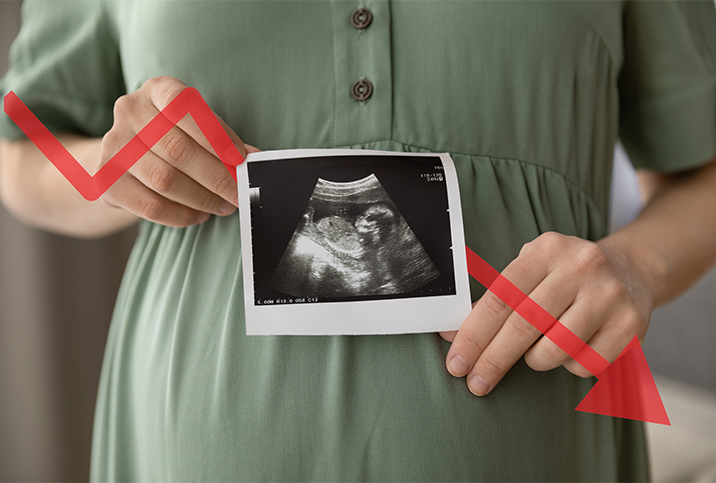Behind the Current Pandemic Surrogacy Shortage

There's no question the COVID-19 pandemic makes life difficult for most families, whether caretaking for existing family members during the lockdown or adding new ones to watch over. People using surrogates over the past couple of years experienced unique challenges as longer wait times, fewer available providers and travel restrictions impeded—and continue to impede—bringing home a new baby.
A sharp decrease in available surrogates
The pandemic created a labor shortage across the country, and the field of surrogacy was no exception. After interviewing 10 surrogacy agencies, the New York Times reported a 60 percent drop in potential surrogates since 2020.
For many providers, health concerns took precedence over surrogacy. Pregnant people were more likely to become severely ill from COVID-19, and the virus is more likely to cause them to deliver preterm or stillborn babies.
"In the beginning of the pandemic, there were fewer women willing to potentially risk their exposure to COVID-19 during a pregnancy and delivery at a hospital if they did not have to," said Kristen Hanson, an owner of Simple Surrogacy, based in Dallas.
Eran Amir is the founder of GoStork, an all-in-one fertility marketplace based in New York City that he developed after going through the surrogacy process.
"The pandemic has definitely impacted women's decisions or ability to embark on becoming a gestational carrier from the general feeling of being burned out, to financial and other stressors, to health concerns from COVID," Amir said.
'If they are pregnant as a surrogate, they are more limited in where they can go with their families this summer, the first real summer of potential travel after widespread COVID.'
"Time away from their families for doctor visits and appointments, and time out being exposed to the virus more than they needed to be was also a factor," Hanson added.
Even as vaccines are readily available in the United States and travel restrictions have lifted, people considering becoming surrogates may still opt out for different reasons.
"As travel opens up, we are also seeing women not wanting to be tied down by pregnancy and the travel limitations at this time, either," Hanson explained. "If they are pregnant as a surrogate, they are more limited in where they can go with their families this summer, the first real summer of potential travel after widespread COVID."
Additionally, as surrogacy agencies typically require surrogates to have proof of prior successful pregnancy, many surrogates are mothers already who have faced the ubiquitous challenges of caretaking and schooling children at home throughout the pandemic.
Longer wait times for a match
Wait times for starting a family through surrogacy increased due to provider shortages.
"We have seen wait times increase by 50 percent this year," Hanson noted.
Many surrogacy agencies state the average wait time for a surrogate is about three to six months, but the process now could take over a year, and that's just to match a surrogate with an intended parent.
"Given that there are more intended parents than available surrogates, some agencies also have very long wait times for matching," said Amir, who is trying to make wait times more transparent for parents on GoStork.
Increased surrogacy costs
Surrogacy has always been expensive: The starting point for surrogacy in the United States is about six figures. If initial attempts at fertilization are unsuccessful, the number can climb steadily.
"A typical surrogacy journey can cost anywhere between $70,000 to $180,000, not including the IVF portion. The total cost for our first surrogacy process was about $200,000. For our second journey, I had already developed GoStork, so we used it to compare all of the agencies' costs and offerings and saved $50K by switching agencies," said Amir, though their total cost still was more than $100,000.
The demand for surrogates during the pandemic has compounded rising prices. Hanson explained that alongside the rising wait times for providers, rising costs have made budgets increase an average of 20 percent to 40 percent for surrogacy costs.
"This is due to the increased demand for a diminished pool of surrogates," Hanson said.
"There are many factors that contribute to the total journey cost and they're not very transparent," Amir said. "This includes everything from the agency fees, gestational carrier fees, legal fees to do the contracts representing both the intended parents and the gestational carrier, screening costs, insurance, other fees and contingencies…it's a long list.
"Each agency also has different cost structures and may include different services within that fee," he added.
Still, Amir is not backing away from the surrogacy process. He and his husband, Michael Gowen, M.D., are embarking on their third surrogacy process after picking up a few lessons along the way.
"If the surrogate has surrogacy-friendly insurance, it can save around $25,000," Amir noted.
Vaccine preferences reduce available surrogates
Differences in vaccine decisions also thwart potential surrogate providers from joining agencies.
"Now that the virus is waning, we are seeing there is a disconnect between people who do not want to be vaccinated and those who want to be surrogates, also causing a shortage," Hanson said.
"Many women who want to be surrogates do not want to be vaccinated [against] COVID-19 because they already have [had] the virus itself," she continued, illustrating a common belief that prior infection can substitute for vaccination. "Most clinics do not take an unvaccinated woman as a surrogate, so those who are unvaccinated cannot be surrogates. This decreases the pool of available women."
Some anti-vax parents adamantly request their surrogates be unvaccinated. Ashley Mareko, program director for California-based agency Surrogate First, told VICE that a quarter of intended parents wanted their surrogate to remain unvaccinated throughout the pregnancy.
Travel restrictions and state laws
Faced with surrogacy's exorbitant costs in the U.S., some parents are looking abroad for surrogates. However, global travel restrictions due to the pandemic have barred people from traveling for appointments or even births in their planned locations.
Particularly worrying is Ukraine, an international surrogacy hub with supportive surrogacy laws. The average price for using a surrogate in Ukraine is $30,000 to $50,000, significantly lower than in the U.S. But war has created unthinkable problems in the country. Pregnant surrogates fear for their lives, while intended parents can't reach their newborn babies.
Many countries exclude same-sex parents from surrogate resources, and even in the U.S., laws governing surrogacy are left to individual states. A handful of states do not recognize gestational surrogacy.
"We also had to find a surrogate that was in a surrogacy-friendly state. I was living in New York during my first surrogacy journey, and compensated surrogacy was illegal at that time," Amir explained. "The surrogacy laws are more important where your surrogate lives than where the intended parents live. You want your gestational carrier to be in a surrogacy-friendly state so that you can more easily establish legal parentage."
Is surrogacy making a rebound?
Renate Klam, director of client relations at Conceptual Options in Poway, California, has seen many pandemic complications affecting surrogacy begin to let up, and this trend includes an uptick in providers.
However, surrogacy might face additional challenges in the next few months. The possible fall of Roe v. Wade could impact in vitro fertilization (IVF), the creation of embryos outside the womb, which is how gestational surrogates become pregnant. Gestational surrogacy accounts for 95 percent of surrogacy in the United States.
"If Roe v. Wade falls, as predicted by the leak from the Supreme Court, the limitation on access to abortion may mean some parents seek surrogacy and IVF in fewer states, which will in turn drive up the costs for surrogacy and assisted reproduction even higher," Hanson said.
The Supreme Court is expected to issue a decision on the landmark case in late June. An overturning of Roe v. Wade could cause decreased surrogacy in anti-abortion states and increased demand in pro-choice states, furthering the gap of providers to parents.
Though the pandemic posed unprecedented challenges for many families, it helped crystalize people's values, such as the decision to create families.
"For many, [COVID-19] was the realization that time is short, that we do not actually have the forever to create our families that we thought, so many decided it was time to get that family they had always hoped for and dreamed about underway," Hanson said. "That demand spread across the country is what is driving this boom for surrogacy need and driving the demand for surrogates."




















